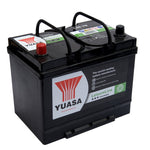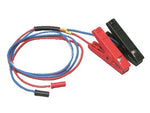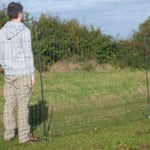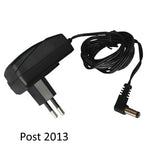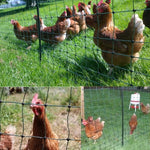You have no items in your shopping cart.
Electric Rabbit Fencing
If you are serious about your gardening or just want to keep rabbits out of your yard, then electric rabbit fencing is the perfect solution for you!
Traditional rabbit fencing usually consists of expensive wire mesh with half of that buried underground to stop them burrowing under. These had to be substantial constructions as can be seen in the diagram and photo. Luckily, these are no longer necessary.
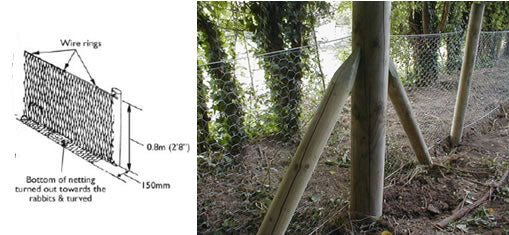
Traditional Rabbit Fencing
Effective Electric Fencing can be erected via two methods:-
- Flexinett Electric Netting. This is highly effective, very portable and very easy to use. All netting systems are resource hungry and do require a larger energizer to run an equal distance.
- Parallel wire systems. (CSI) These require more precise erection but may still be regarded as temporary. They are cheaper and require fewer resources than a netting system.
The efficacy of the two systems may be judged by the results of a trial carried out by the Central Science Laboratory on behalf of the Horticultural Development Council in Cornwall. As may be seen from the results reproduced here both methods were far more effective than the farmers own fence used to protect his Cauliflowers. No more than a single rabbit was ever seen in either of the two systems, by contrast, up to 20 were seen in the control on any night.
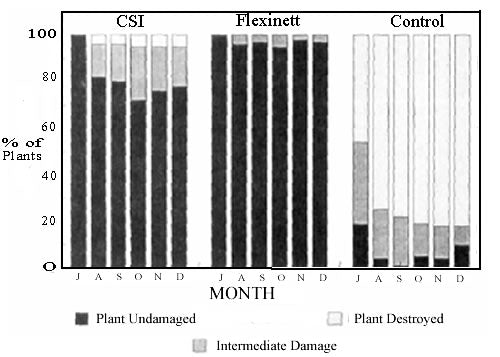

The majority of rabbits touch the live wires of the fence with their noses, receive a shock, and retreat into the harbourage. This created the psychological impression associated with Electric Fences and prevented their return. The number observed testing the fence also decreased with time with up to 65% fewer observations within weeks of erecting the fence.
Rabbits were not found to have burrowed under the fences at all and a few were seen to jump through. These could have been eliminated by the use of bait caps.
Trials to determine the number of years of useful life of electric netting fences were terminated after seven years at the end of which they were working effectively. However, if maintenance is poor or nets are regularly moved, the useful life of the fence will be considerably shortened because of the damage rabbits will do to it by chewing and mechanical damage to the filaments.
The farmer on whose land the research was conducted estimated that the additional profit arising from subsequent yield increases was sufficient to cover the costs of Electric Fencing in one year and of Electric Netting in two.
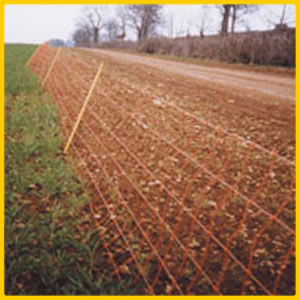
Erected Flexinett
Note the angle at which the Flexinett is tilted.
Electric netting is purchased as a stand-alone product as may be seen pictured in the image above. Tips on erecting the net. These nets are then attached to a suitable energizer. Netting is very resource hungry and require stronger energizers.

Erected Line Fencing
Note the angle at which the fence is tilted.
Line fences are constructed using standard fencing equipment. Tips on fence erecting and installation are available. In addition to the four wires suggested, I tend to put a return-earth against the ground. This is connected to the earth stake and is not energized. The function of this is to improve the contact between the rabbit and the ground. The picture shows the attachment of a Bait cap. Both these techniques will increase the effectiveness of the fence.
The type of energiser is not as critical as the requirement for dear but a good agricultural fence energiser would be preferable to one that caters for horses.
When deterring rabbits the net or fence is best erected at a 35 degree angle facing the direction from where the rabbits come from so that the ears of the rabbit touch the net before it can get close to the fence. The shock the animal receives will not harm it at all but it will learn to keep away from the fence.
- Electric Netting
- Tape, Twine, Wire And Rope
- Fencing Energisers
- Fencing Posts
- Insulators
- Accessories
- Electric Fencing Kits
- Chicken Feeders and Drinkers
-
Information
- What is Electric Fencing
- Advantages of an Electric Fence
- Installing a Fence
- How to Erect a Net
- What you Need for a Fence
- Testing an Electric Fence
- Quantities Guide
- Improve Your Fence
- Poultry Netting Trial
- Electric Netting Dimensions
- Electric Fencing Mistakes
- TLD Max Technology
- Energiser Terminology
- Choosing an Energiser
- Fencing Articles
- Trouble Shooting
- Delivery Terms
- Frequently Asked Questions
- Here's a Blog Worth Reading
- Price
-
-
Below $100.00
-
$100.00-199.00
-
$200.00-299.00
-
$300.00-399.00
-
$400.00-499.00
-
Above $500.00
-
- Color
-
-
- Size
-
-
S
-
M
-
L
-
XL
-
2XL
-
3XL
-
- Brand
-
-
Adidas
-
Camel
-
Motorola
-
Rolex
-
Samsung Galaxy
-
Seiko
-
Sony
-

